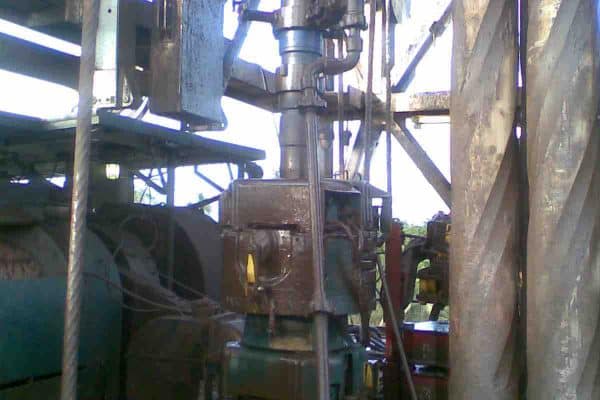Before we delve into the primary cementing checklist, imagine that you are the person in charge of well construction operations.
It is nighttime, and the company man is resting (contrary to ‘normal’ people, a co-man needs noise to properly rest, because noise means that ‘all is working’).
As a junior or night well site leader you have done and seen this many times, but still, you want to be sure. The cementer looks ‘ok’ but can you trust him/her? As I said, you want to be sure, right? In the end, you are the one in charge.
This primary cementing checklist can help you!
Download document: checklist cementing
| Primary Cementing Guide | |||
| A. | General | ||
| 1 | Supervise all Companies involved in the safe execution of the cement job. | ||
| 2 | Verify that the final slurry recommendation in the cement program meets the job objectives and requirements including in the drilling program. | ||
| Cement Slurry Composition | |||
| Fresh water tested for chlorides | |||
| Slurry density | |||
| Thickening time | |||
| Rheology | |||
| Compressive strength | |||
| Fluid Loss | |||
| Free water | |||
| 3 | Ensure Service Company is advised of the time they are expected at the location and of any site-specific requirements. | ||
| 4 | Ensure that all Companies are contacted and informed in time to complete these preparations for the job. | ||
| 5 | Review with the cementing contractor that there are sufficient resources to prepare and execute the cement job. | ||
| B. | Before RIH Casing | ||
| 1 | Confirm that the float equipment is checked for debris and threads are OK. (Also confirm operation of float equipment during casing running operation). | ||
| 2 | If a stage collar is being used, confirm it has been checked for the closed position, it is clear of debris and the threads are not damaged. | ||
| 3 | While circulating the hole clean and conditioning the mud, check the mud and ensure that the properties are as per plan. Cross check with the cementing program. | ||
| 4 | Review the casing tally and check if sufficient centralizers and stop collars are available on-site. | ||
| 5 | Caliper casing ID for displacement calculation (10% of joints). | ||
| 6 | Review and understand planned contingencies described in the drilling program, cement proposal and/or signed MOC. | ||
| 7 | Review the cement program and check the slurry volumes as per the caliper log and excess. Calculate and check the displacement volume. Inform the field personnel or drilling engineer in case of any discrepancy. | ||
| 8 | Ask the mud supervisor to check the mix water salinity. Report results to the job supervisor or drilling engineer. | ||
| 9 | Witness the loading of plugs in the cement head. | ||
| C. | While RIH Casing | ||
| 1 | Witness the making up of the float equipment (thread lock compound should be used). Mostly the Casing shoe will be made up as an offline job on the ground or before being dispatched to the rig; (witnessing is required). | ||
| 2 | Sporadically visit the rig floor to check the make-up torque, running speed including setting and pulling of slips, safe working practices, running tally; | ||
| 3 | Monitor mud return on the shale shakers due to casing displacement while RIH and report if any mud loss; | ||
| 4 | When the casing shoe reaches the setting point, circulate to clean the hole and condition the mud. Check the mud and ensure that the properties are as planned. Cross-check with the cementing program. | ||
| 5 | Apply casing movement as described in the drilling program. | ||
| 6 | Record the circulation pressure vs SPM. Crosscheck with the cementing contractor’s pre-job simulations. | ||
| 7 | Check rig pump efficiency and recalculate displacement strokes depend on the actual pump efficiency. (Even if the rig pumps aren’t planned to do the primary displacement, they shall still be available as a contingency). | ||
| D. | Cement Slurries design | ||
| 1 | Confirm with the cementing contractor that the laboratory tests have been performed with actual field blend samples and materials planned for the job. | ||
| 2 | Confirm with the cementing engineer that sufficient and contingency materials (normally 100% extra) are available at the location. | ||
| 3 | Ensure the thickening time of the cement slurry is greater than the planned job time, including mixing time. (Review the cementing contractor policy or guideline for thickening time). | ||
| 4 | Review compressive strength development indicated by laboratory testing (UCA chart) against the timeline for subsequent operations (pressure testing, barrier removal, drill out). | ||
| E. | Cementing Equipment | ||
| 1 | Confirm with the Cement Engineer that all cement unit maintenance is current and all pressure retaining equipment (e.g. cement heads/ chiksans) have appropriate testing/certification. | ||
| 2 | Confirm that adequate wash-up procedures and disposal plans have been made by the cementing contractor. | ||
| 3 | For surface cement heads, confirm that o-rings, valves and manifolds are OK and that the pipe seals and indicator system are functioning. | ||
| F. | Job Planning | ||
| 1 | Review job simulation from the Cement Company and ECD predictions at relevant depths. Review the proposed pumping schedule with the Cement Engineer and Drilling Contractor. | ||
| 2 | Review the field spacer properties against planned design; confirm it has been amended to deal with any changes in mud properties required during the drilling phase. | ||
| 3 | Review and communicate plans for mud and hole conditioning, equipment clean-up and disposal of contaminated returns. | ||
| 4 | Review the contingencies included in the drilling and/or cement program. | ||
| G. | Cement Slurries pumping | ||
| 1 | Check job data recorder in the cement unit is working. | ||
| 2 | Check the indicator on the cementing head to be sure the bottom plug (when applicable) has dropped. | ||
| 3 | Record the initial and final pump pressure. | ||
| 4 | Check with mud balance pumped density, at least, every 2-4 minutes. | ||
| 5 | Monitor for losses; if losses are observed. Implement planned contingencies. | ||
| 6 | Take samples of the cement blend, mix water and cement slurry. | ||
| H. | Cement slurry displacement | ||
| 1 | Check the indicator on the cementing head to be sure the top plug/dart has dropped. | ||
| 2 | Bump the top plug as described in the cementing program. Implement detailed contingencies if required. | ||
| 3 | Report the final circulating pressure and applied casing test pressure as described in the drilling and/or cement program. | ||
| 4 | Check the float equipment as described in the cementing program. | ||
Please let me know your comments or suggestions in order to improve this primary cementing checklist.
Cheers
L. Diaz



The recommendations in this list are very good to be taken into account in a cementing job. Although, I think you are referring only to the operational part. We have a checklist but more concerning engineering
regards.
Thanks Victor, I would be great if you can share an expanded list.
Dear Diaz,
Kindly want to let you know of that you are doing a wonderful job here in this your platform. I called this your educative writeup ” oil well cementing made easy”
Diaz, we completed a 9 5/8″ production casing cementing job few weeks ago.
Mixed water was prepared accordingly(lead and tail) though stayed around 18hours prior commencement of real cementing job due to difficulty in releasing casing fill up tool by the casing crew as a result of high stick up casing landing joint.
Again, we had three wiper plugs(2 bottom and 1 top) based on client request. The arrangement(way) plugs were released is as stated below:
1) 1st bottom plug was released after pumping 100bbls of 11.87ppg weighted spacer.
2) 2nd bottom plug was released after pumping lead slurry of 12.5ppg .
3) 3rd plug which is top plug was released after pumping the tail slurry of 15.8ppg weight.
We commenced displacement of cement slurry using rig pump with SOBM at a rate of 12.bpm.When we had pumped a total of 815bbls out of 874bbls according to rig pump counter and physical tank measurement with deep stick, noticed pressure increased up to 4500psi with no returns on surface.
Kindly note, through out the time we were trying to release casing fill-up tool mud in hole was left static over 17hours without any form of circulation apart from 15bbls of water pumped using cement unit in braking circulation prior commencement of cementing job.
Rig finally ran back in hole and tagged hard cement shallower than expected.
Could there be any effect of using three plugs(2bottom and 1top) in a single stage cement job?
Appreciate all your teaching in this forum.’
Hi Otsuma,
Let just see if I understand correctly, basically there was a sudden increase in pressure earlier than expected 59 bbl earlier.
What was the volume of tail slurry?
Do you think is it possible the 2nd bottom plug didn’t burst?
What is the depth 3500 or more?
With no previous circulation the mud adhered to the casing’s wall probably got thicker as the mud gelled up. In normal conditions this thickness is limited by the Yp and pumping rate, with mud immovable then the gels can play a bigger role.
With two bottom plugs, I would say the first one has the highest possibility not to burst, keep in mind this immovable mud is now being wiped underneath the bottom plug. However bottom plugs are not the most efficient is wiping this mud from the casing walls, that role is for the top plug and that is the reason for the shoe track and received this mud contaminated cement and protect the shoe.
In your case, as I mentioned probably the trigger was the time the mud was left without circulation.
Dear Diaz,
Thanks very much for your quick response.
Depth of the well was 12070ft.
Volume of lead slurry 342bbls(12.5ppg)
Volume of tail slurry 311bbls(15.8ppg).
You know the decision to use two bottom plugs was from the client though resisted initially. Their believe currently now is cement flash set while still displacing cement slurry.
They actually meet 2800ft of cement in casing as result of not been able to displace further due to pressure build up.
My takes was though the bottom plug may have ruptured when it rested on the float collar as a solid base but second plug alignment especially with that high rate of displacement at 12bpm(turbulent) could cause some issues.
Appreciate greatly what you are doing for the masses.
Best Regards,
Otsuma,Linus
Hi Otsuma,
2800 ft is about 198 bbl, this is more than the difference in displacement volume (874 vs 815 bbl), is that correct?
How is the pressure profile before it reached 4500 psi?
I am thinking the time with no circulation is still the trigger, and the plugs might be still playing a role, but with this new information is not as simple as I assumed with the initial data.
One of the things I do is “forensic” cementing, basically investigating job outcomes to find the root cause. If the customer is interested in a 3rd party assessment, let me know.
Cheers
L. Diaz
Noted.